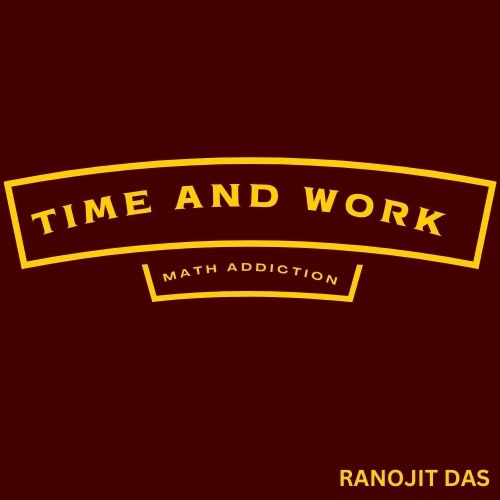Introduction:
In competitive exams, mastering time and work problems is crucial for success, as they frequently appear across various aptitude tests. Time and work problems access an individual’s ability to understand and apply mathematical concepts related to efficiency, productivity, and teamwork. To excel in these exams, candidates must have a strong grasp of the underlying principles and formulas governing time and work scenarios.

Table of Contents
Understanding the Basics of Time and Work
Time and work problems typically involve calculating the time taken to complete a task when one or more individuals work together at different rates. The fundamental concept revolves around the idea that the total work done is equal to the product of the rate at which work is done and the time taken to complete it.
Basic Formulas of Time and Work
1. Work Done (W): It represents the total amount of work to be done.
W = Rate × Time
2. Time (T): It represents the duration required to complete a certain amount of work.
T = w/Rate
3. Rate: It represents the work done per unit of time.
R = W/T
Types of Time and Work Problems:
- Single-person problems: Involving scenarios where a single individual completes a task.
- Multiple-person problems: Involving scenarios where multiple individuals work together to complete a task.
- work allocation problems: Involving scenarios where individuals work at different rates or efficiencies.
Solving Single-Person Problems:
In single-person problems, the formula T = w/Rate is often used to determine the time taken by an individual to complete a given task. Candidates must carefully read the problem statement to identify the work to be done and the rate at which the individual works.
Example: If John can complete a project in 10 days working alone, calculate the total work done by John in 1 day.
Solution: Given, John can complete the project in 10 days.
so, his rate of work = 1/10 of the project per day.
Solving Multiple-Person Problems:
In scenarios where multiple individuals work together, the concept of combined rates is crucial. The formula T = w/Rate is still applicable, but the total rate is the sum of the individual rates.
Example: If Rahul can complete a project in 12 days and Jill can complete the same project in 8 days, calculate the the time taken for both Rahul and Jill to complete the project togther.
Solution: Rahul’s rate = 1/12 project/day
Jill’s rate = 1/8 project/day
Combined rate = Rahul’s rate + Jill’ rate
Combined rate = 1/12 + 1/8 = 1/6 project/day
Time taken = w / combined rate= 1÷ 1/6 = 6 days
Solving Work Allocation Problems:
In scenarios where individuals have different rates or efficiencies, the work done by each individual must be calculated separately using the formula W = Rate × Time.
Example: If Tom can complete a project in 15 days and Jerry can complete the same project in 10 days, but Tom works only half as efficiently as Jerry, Calculate the portion of work each person will complete in one day.
Solution: Tom’s rate = 1/15 project/day
Jerry’s rate 1/10 project/day
Tom’s efficiency = 1/2 (compared to Jerry)
Adjusted rate for Tom = 1/2 × 1/15 = 1/30 project/day
Portion of work completed by Tom in one day= 1/30
Portion of work completed by Jerry in one day = 1/10
Some More Important Time and work Formulas
1. If M1 men finish W1 work in D1 days , working T1 time each day and M2 men finish W2 work in D2 days, working T2 time each day then, (M1 D1 T1)÷ W1 = (M2 D2 T2 ) ÷ W2
2. If X can finish a/b part of the work in D days. Then, total time taken to finish the work by X = b/a ×D
3. If A alone can do a certain work in “x” days and A and B together can do the same work in “y” days then B alone can do the same work in, (x × y) ÷ (x – y)
Solved Example:
1. 5 men can finish a project in 10 days working 8 hours each day. How many men will be needed to finish the same work in 5 days working 4 hours each day?
Solution: Given,
M1 =5, D1 =10 days, T1 = 8 hours,
M2 = ? D2= 5 days, T2 = 4 hours
We know that, 5 × 10 × 8 = ? × 5 × 4
= 400 = ? × 20
= M2 = 20
2. The efficiencies of A, B, C are in the ratio 2 : 5 : 3. Working together, they can complete a task in 12 days. In how many days can A alone complete 30% of the work?
Solution: Total work= total efficiency × Number of days
= (2 + 5 + 3) × 12 = 120 unit
= A’s time to do 30% of work = (120 × 30) ÷ (2 × 100)
= 18 days.
3. Two men and 7 women can complete a work in 28 days whereas 6 men and 16 women can do the same work in 11 days. In how many days can 7 men complete the same work?
Solution: (2M + 7W) ×28 = (6M + 16W) × 11
= 56M + 196W = 66M + 176W
=10M = 20W
= M : W = 2 :1
Total work = (4 + 7) × 28 = 308
Days when work done by 7 men = 308 ÷ (7 × 2) = 308 ÷ 14 = 22
Recommended Reading
How Ratio is Different from Proportion in Math?
FAQs
1.Q What is time and work?
Time and work is a mathematical concept that deals with calculating the amount of work done by a person or a group of people over a certain period of time.
2.Q What are some common types of time and work problems?
l. A person working alone.
ll. Two or more people working together.
lll. Work done in shifts or alternating periods.
lV. Efficiency or productivity rates.
3.Q How can I improve my skills in solving time and work problems?
l. Practice solving different types of time and work problems regularly.
ll. Break down complex problems into smaller, more manageable parts.
lll. Understanding the relationship between time, work and rate.
4.Q How do you determine the rate of work?
The rate of work is determined by how much work is completed per unit time. It is often expressed as the fraction of work completed per hour or per day.
